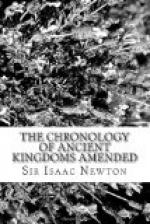selene. esti de to men kath’ helion agein tous
eniautous, to peri tas autas horas tou eniautou tas
autas thysias tois theois epiteleithai, kai ten men
earinen thysian dia pantos kata to ear synteleithai;
ten de therinen, kata to theros; homoios de kai kata
tous loipous kairous tou etous tas autas thysias piptein.
Touto gar hypelabon prosenes, kai kecharismenon einai
tois theois. Touto d’ allos ouk an dynaito
genesthai, ei me hai tropai, kai hai isemeriai peri
tous autous topous gignointo. To de kata selenen
agein tas hemeras, toiouton esti; to akolouthos tois
tes selenes photismois tas prosegorias ton hemeron
ginesthai. apo gar ton tes selenes photismon hai prosegoriai
ton hemeron katonomasthesan. En hei men gar hemerai
nea he selene phainetai, kata synaloiphen neomenia
prosegoreuthe; en hei de hemerai ten deuteran phasin
poieitai, deuteran prosegoreusan; ten de kata meson
tou menos ginomenen phasin tes selenes, apo autou
tou symbainontos dichomenian ekalesan. kai katholou
de pasas tas hemeras apo ton tes selenes photismaton
prosonomasan. hothen kai ten triakosten tou menos
hemeran eschaten ousan apo autou tou symbainontos
triakada ekalesan.] Propositum enim fuit veteribus,
menses quidem agere secundum Lunam, annos vero secundum
Solem. Quod enim a legibus & Oraculis praecipiebatur,
ut sacrificarent secundum tria, videlicet patria,
menses, dies, annos; hoc ita distincte faciebant universi
Graeci, ut annos agerent congruenter cum Sole, dies
vero & menses cum Luna. Porro secundum Solem
annos agere, est circa easdem tempestates anni eadem
sacrificia Diis perfici, & vernum sacrificium semper
in vere consummari, aestivum autem in aestate:
similiter & in reliquis anni temporibus eadem sacrificia
cadere. Hoc enim putabant acceptum & gratum esse
Diis. Hoc autem aliter fieri non posset nisi
conversiones solstitiales & aequinoctia in iisdem Zodiaci
locis fierent. Secundum Lunam vero dies agere
est tale ut congruant cum Lunae illuminationibus appellationes
dierum. Nam a Lunae illuminationibus appellationes
dierum sunt denominatae. In qua enim die Luna
apparet nova, ea per Synaloephen, seu compositionem
[Greek: neomenia] id est, Novilunium appellatur.
In qua vero die secundam facit apparitionem, eam secundam
Lunam vocarunt. Apparitionem Lunae quae circa
medium mensis fit, ab ipso eventu [Greek: dichomenian],
id est medietatem mensis nominarunt. Ac summatim,
omnes dies a Lunae illuminationibus denominarunt.
Unde etiam tricesimam mensis diem, cum ultima sit,
ab ipso eventu [Greek: triakada] vocarunt.
The ancient Calendar year of the Greeks consisted therefore of twelve Lunar months, and every month of thirty days: and these years and months they corrected from time to time, by the courses of the Sun and Moon, omitting a day or two in the month, as often as they found the month too long for the course of the Moon; and adding a month to the year, as often as they found the twelve Lunar months too short for the return of the four seasons. Cleobulus,




